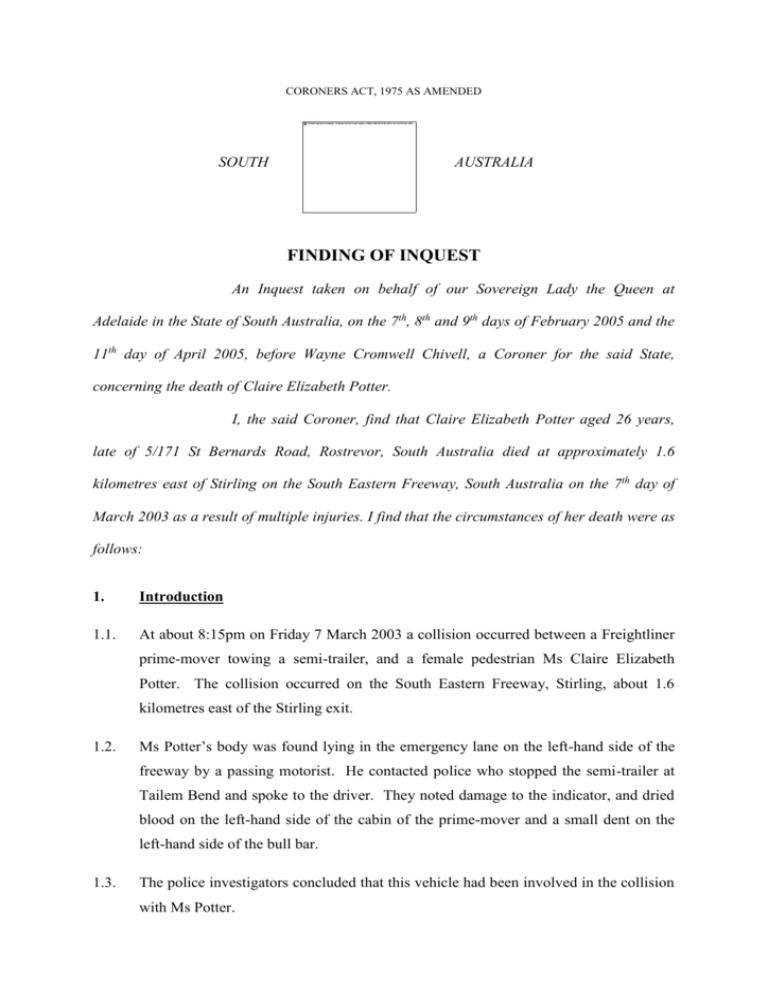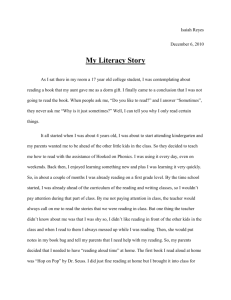POTTER Claire Elizabeth
advertisement

CORONERS ACT, 1975 AS AMENDED SOUTH AUSTRALIA FINDING OF INQUEST An Inquest taken on behalf of our Sovereign Lady the Queen at Adelaide in the State of South Australia, on the 7th, 8th and 9th days of February 2005 and the 11th day of April 2005, before Wayne Cromwell Chivell, a Coroner for the said State, concerning the death of Claire Elizabeth Potter. I, the said Coroner, find that Claire Elizabeth Potter aged 26 years, late of 5/171 St Bernards Road, Rostrevor, South Australia died at approximately 1.6 kilometres east of Stirling on the South Eastern Freeway, South Australia on the 7th day of March 2003 as a result of multiple injuries. I find that the circumstances of her death were as follows: 1. Introduction 1.1. At about 8:15pm on Friday 7 March 2003 a collision occurred between a Freightliner prime-mover towing a semi-trailer, and a female pedestrian Ms Claire Elizabeth Potter. The collision occurred on the South Eastern Freeway, Stirling, about 1.6 kilometres east of the Stirling exit. 1.2. Ms Potter’s body was found lying in the emergency lane on the left-hand side of the freeway by a passing motorist. He contacted police who stopped the semi-trailer at Tailem Bend and spoke to the driver. They noted damage to the indicator, and dried blood on the left-hand side of the cabin of the prime-mover and a small dent on the left-hand side of the bull bar. 1.3. The police investigators concluded that this vehicle had been involved in the collision with Ms Potter. 2 1.4. The driver of the semi-trailer, Mr Daniel Heppell, told police that he was unaware that he had collided with a person. The place where the collision occurred was very dark. There were no street lights in the area. Mr Heppell said that he heard an impact, and thought that he may have hit an animal, or blown a tyre. Later, he noticed that his left indicator was not working, so he stopped in a parking bay and saw that it had been smashed. He did not see blood on the semi-trailer at that time (Exhibit C8b). 1.5. It transpired that Ms Potter had been a detained patient at the Glenside Campus of the Royal Adelaide Hospital. She had initially been detained on 5 March 2003 at the North Terrace Campus of the hospital pursuant to Section 12(1) of the Mental Health Act 1993 (‘the Act’), and this detention was confirmed on 6 March 2003 pursuant to Section 12(4) of the Act. 1.6. Accordingly, at the time of her death Ms Potter was ‘detained in custody pursuant to an Act or law of the State’ within the meaning of Section 12(1)(da) of the Coroners Act 1975, and an Inquest into her death was therefore mandatory by virtue of Section 14(1a) of the said Act. 1.7. The investigators from the Major Crash Investigation Unit, Senior Constables Keir and Bakker, have found that there were no witnesses to the collision and there is no evidence that the driver of the semi-trailer had seen Ms Potter prior to the collision. It is not known whether she was standing or walking on the road, or in what position. It seems likely that she was in the left lane or at the left-hand edge of the road having regard to the damage visible on the prime-mover of the semi-trailer. The section of the road in which the collision occurred was extremely dark. It is not known how Ms Potter went from Glenside Campus to the point of collision. It seems likely that she obtained a lift, and was dropped in the area from another vehicle. 1.8. The investigators concluded that there was no evidence to support any charges against the driver of the semi-trailer, and accepted that he was unaware that the collision had occurred. 2. Cause of death 2.1. A post-mortem examination of the body of the deceased was performed by Dr Allan Cala, then Chief Forensic Pathologist at the Forensic Science Centre. Dr Cala noted horrific injuries, including massive facial lacerations and fractures, as well as massive 3 injuries to the chest and internal organs as well as compound fractures of the right arm and left leg. 2.2. Dr Cala found that the cause of Ms Potter’s death was multiple injuries. He commented: '… Post-mortem examination showed massive injuries to the face, trunk and limbs. There were multiple rib fractures as well as fractures of the left tibia and fibula and right radius and ulna. The base and vault of skull were also fractured. There was a pattern abrasion on the right thigh consistent with a tyre mark. A strip of tyre was located in the inner part of the jeans on the right side. I believe the deceased died as a result of multiple injuries consistent with being struck by a moving vehicle …' (Exhibit C2a, pp2-3) 2.3. A toxicological analysis of Ms Potter’s blood taken at post-mortem disclosed the following: '1. The blood contained approximately 0.1mg olanzapine per L. (uncertain significance) 2. None of the drugs amphetamines, benzodiazepines, methadone, tricyclic antidepressants, opiates, cannabinoids and other common basic drugs were detected in the blood. 3. Alcohol was not detected in the blood.' (Exhibit C3a, p1) 2.4. In a further report, Mr Harpas, Senior Forensic Scientist, states that a further analysis of the blood produced the following results: '1. Detected in the blood (peripheral): (1) 46mg valproic acid per litre (non toxic/therapeutic concentration) (2) approximately 0.06mg zuclopenthixol per litre (non toxic/therapeutic concentration)' (Exhibit C3b, p2) 3. Background 3.1. Mrs Karen Potter, Claire’s mother, said in her statement that her daughter had suffered from schizo-affective disorder for the previous eight years. She said: 'Over the course of Claire’s illness, she has been to Glenside Hospital, the Royal Adelaide Hospital, the Queen Elizabeth and the Adelaide Clinic about 10 times in total 4 and she has had a history of absconding from those places. In total, she has absconded on about 6 occasions. She has a history of wanting to go to Melbourne and there seems to be an attraction to Melbourne for her for some reason. Apparently she had been to Melbourne on the train on the Monday and Tuesday before being taken to the Royal Adelaide Hospital. We got this information from Paul Botting, Claire’s boyfriend. Paul used to live with Claire at the Rostrevor address but had moved out recently because of Claire’s behaviour. Paul also suffers from a mental illness and is also on medication. Over the years, Claire has become increasingly violent and on Christmas Day last year, the police had to be called to our home when Claire punched me in the face. In October, 2001, she was carrying a small knife in her handbag which she claimed she needed to ‘protect herself from the Devil’. At around that time, she also punched her psychiatrist. Back in 1994 she didn’t get into university and shortly after that, she began using marijuana and LSD. The symptoms started to appear then and we were told by doctors that it was possible her condition may always have been there and the drug use just triggered it off. She has attempted suicide before, including taking a drug overdose and on one occasion she lay on a highway in Canberra. On that occasion, she claimed it was necessary to die in order to save someone else’s life. When she was ill and not taking her medication, she had very strong religious delusions and even when she was on her medication, she was still fairly unstable.' (Exhibit C6a, pp3-4) 4. Events leading to detention order 4.1. Ms Potter received fortnightly injections of zuclopenthixol, an anti-psychotic medication, as required by a Community Treatment Order. These were administered at the Felixstow office of Community Mental Health Services. Ms Potter failed to attend for the injection due on 25 February 2003. 4.2. Mrs Karen Potter expressed her concerns to her daughter’s case workers that her daughter had not received the injection, and about her increasingly disturbed behaviour. The Community Mental Health Service records detail the attempts made by the case workers to contact Ms Potter and to administer the medication. 4.3. Finally, on 5 March 2003, after a report from Ms Potter’s boyfriend that she had taken his car and damaged another, case workers and police located Ms Potter and took her to the Royal Adelaide Hospital for assessment. 5. Treatment at the Royal Adelaide Hospital 5.1. Ms Potter was transported to the Royal Adelaide Hospital Emergency Department by mental health workers during the afternoon of 5 March 2003. She was seen there by 5 Dr Christina Lawry, who was then a Psychiatric Registrar in the third year of her training. Dr Lawry was a member of the Assessment and Crisis Information Service (‘ACIS’) Hospital Support Team. 5.2. Dr Lawry said: 'As the first part of the assessment I spoke with community workers. They provided the history that Ms Potter was well known to their service with a history of Bipolar Affective Disorder. They told me of her usual prescribed medication and that she was currently on a Community Treatment Order until December 2003. She had not attended for her most recent Depot medication on 25th February 2003. They described recent reports from her partner and family of concern for her mental state. They described increasing aggression, delusional ideas and erratic behaviour. The community workers had responded to a call from her partner that day and attended Ms Potter’s home where she resided with him. The community workers stated that she was cooperative and agreed to attend the Royal Adelaide Hospital for assessment and they transported her to the hospital.' (Exhibit C16, p1) 5.3. Dr Lawry interviewed Ms Potter and found that although she was cooperative and pleasant and there were no signs of agitation or rapid speech or disorder of thought, she was ‘somewhat guarded’, had a ‘limited willingness to provide many details about her recent experiences’, and her affect was ‘bland rather than elevated, depressed or angry’ (Exhibit C16, p2). 5.4. The Community Mental Health Workers gave Dr Lawry a lengthy history of psychiatric illness, recent psychotic and risky behaviour, and that she was in breach of the Community Treatment Order and had not had a recent depot medication. Dr Lawry concluded that Ms Potter required inpatient treatment, that treatment was available, and that she posed a risk to herself and/or others if she were not detained. Accordingly, Dr Lawry made an order pursuant to Section 12(1) of the Act detaining Ms Potter to the Royal Adelaide Hospital (see Exhibit C18). 5.5. Dr Lawry said that Ms Potter received her depot medication from the ACIS nurse in the Emergency Department that afternoon, and this is noted on a faxed copy of her community treatment record (Exhibit C18) 5.6. Dr Lawry ensured that Ms Potter also resumed her usual medication, namely olanzapine, sodium valproate, benzodiazepines and paracetamol. 6 5.7. Despite the fact that Ms Potter was detained, she was admitted to an open, non-psychiatric bed in Ward Q8 of the hospital, as no psychiatric beds were available. She was regarded as an ‘outlie’ in the hospital under the ACIS Hospital Support Team. Since she was not in a psychiatric ward, Ms Potter received one to one supervision. 5.8. Ms Potter was reviewed, as required by the Act, within 24 hours, namely at about 9am on 6 March 2003, by Dr Helen Marmanidis, a Senior Visiting Consulting Psychiatrist attached to the Hospital Support Team. 5.9. Dr Marmanidis explained that the Hospital Support Team provides a ‘caretaker role’ while a patient is placed in an outlying bed, which could be anywhere in the hospital, until a psychiatric bed becomes available. Psychiatric beds are in Ward C3 of the Royal Adelaide Hospital. 5.10. Dr Marmanidis had no memory of the details of her Mental State Examination of Ms Potter. She endorsed the clinical record as follows: 'Non-compliant with medication despite Community Treatment Order; Behaviourally disorganised/dangerous; Requires inpatient stabilisation.' (Exhibit C18) 5.11. Dr Marmanidis endorsed the Form 2 Confirmation Form as follows: 'She has been non-compliant with the Community Treatment Order, has been violent and has been driving dangerously.' (Exhibit C4b) 5.12. Dr Marmanidis explained that her reference to Ms Potter being ‘dangerous’ referred to the dangerous driving and came from the history she had been supplied with. She said that she did not find Ms Potter to be exhibiting dangerous behaviour at the time of her interview. She said that she was mainly concerned with her non-compliance with medication, and it was this that she thought required inpatient stabilisation (T65). 5.13. Dr Marmanidis said that she did not regard Ms Potter, on the basis of her interview, as an absconding risk. She said that if she had been displaying acute psychosis or severely disturbed behaviour, she would have recommended a closed ward, but not 7 otherwise (T64). She said that she does not remember being aware of any history of absconce (T67). 5.14. Registered Psychiatric Nurse Julie-Anne Reilly was a Clinical Nurse Consultant and was part of the Hospital Support Team at the Royal Adelaide Hospital. 5.15. RPN Reilly did not attend Dr Marmanidis’ review interview with Ms Potter, but she received a handover from Dr Lawry later that morning. She was told that Ms Potter was compliant and settled, and that the detention order had been made on ‘collateral information’ rather than on her presentation. RPN Reilly knew Ms Potter from previous admissions (T139). 5.16. The Hospital Support Team had a policy that patients on their list who were accommodated in various parts of the hospital were to be reviewed on a daily basis. It was accepted that Dr Marmanidis’ review was purely for the purpose of the confirmation or revocation of the detention order, and did not constitute a full mental state assessment. 5.17. According, RPN Reilly was required to review Ms Potter some time on 6 March 2003. 5.18. RPN Reilly visited Ms Potter during the afternoon of 6 March 2003 but she was sleeping peacefully when she arrived. RPN Reilly decided to leave her rather than waking her up to perform the assessment. Her note at 3:45pm reads: 'Patient asleep. Will review mental state tomorrow, plan to continue as per Dr Lawry’s documentation yesterday and Dr Marmanidis’ review today. One to one observation to continue, no eastern beds available today. Please page after hours Psych Reg if needed.' (Exhibit C20) 5.19. RPN Reilly did not see Ms Potter again until she was informed by the staff in Ward Q8 that there was a bed available for Ms Potter at Glenside Hospital. 5.20. RPN Reilly organised the documentation required for Ms Potter’s transfer, including arranging for Dr Beckwith to sign the transfer form. She then proceeded to Ward Q8 where Ms Potter was gathering her belongings ready for the transfer. She said that Ms Potter appeared happy to leave the medical ward, and gave no signs of distress or psychiatric disturbance. She did not conduct a detailed examination of Ms Potter at that time. 8 5.21. RPN Reilly said that she made an entry in the clinical record to this effect although this note appears to have been lost. The nursing staff on Ward Q8 were instructed to copy the note and forward it with other notes of her current admission to Glenside Hospital for their information. The note does not appear in the Glenside Hospital clinical record either. RPN Reilly said that loss of notes in the course of a transition such as this was ‘not uncommon’ (T138). 5.22. A computer record from the SA Ambulance Service (Exhibit C22) indicates that an ambulance was requested at 1331 (1:31pm) that day. This was almost two hours before RPN Reilly was advised of the impending transfer. The ambulance was not despatched until 3:22pm, and arrived at the hospital at 3:48pm. It departed the Royal Adelaide Hospital at 4:05pm and arrived at Glenside Hospital at 4:19pm. 5.23. RPN Reilly said that she was prevented from conducting a full Mental State Examination of Ms Potter prior to her transfer to Glenside Hospital by the imminent arrival of the ambulance. It is most unfortunate that the staff of Ward Q8 did not advise her prior to 3:20pm that the transfer was to take place. Had they done so, RPN Reilly would have had almost two hours to conduct her examination prior to the transfer. 5.24. On 7 March 2003, Dr Andrew Beckwith, Consultant Psychiatrist, signed a Form 8 authorising Ms Potter’s transfer from Royal Adelaide Hospital to the Glenside Campus (Exhibit C17a). 5.25. Dr Beckwith said that he did not personally interview Ms Potter before doing so - he agreed with the information on the form, which had already been written out by another staff member, and signed it because transfer to a psychiatric bed, whether in Ward C3 of the Royal Adelaide Hospital or at Glenside, was in accordance with Ms Potter’s management plan (T49-T50). 6. Admission to Glenside Hospital 6.1. Ms Potter arrived at Glenside Hospital at between 4:30pm and 5pm by ambulance. She was received by Registered Mental Health Nurse Imelda Dunn who was on duty at Cleland House that evening. 9 6.2. RN Dunn gave a detailed statement to Detective Mazik, who investigated this matter on my behalf, on 15 April 2003. She is now overseas and unavailable to give oral evidence. She said that she received the Royal Adelaide Hospital clinical record of the current admission and the relevant detention forms. She checked Ms Potter’s handbag. She said: 'My impression was that she wasn’t rude or impolite to me but eager to go outside and sit out the front with the other patients and have a cigarette. I asked her if she had any thoughts of self harm and she said, ‘No’. She did not appear agitated or restless. I told her it was okay to go outside, but not to go any further and reminded her she was detained. I then explained to her what that meant. I told her I would be in the office to list her property and would get her to sign the list. She said ‘Okay’.' (Exhibit C13a, p2) 6.3. RN Dunn completed the property list and then showed Ms Potter to her room. Ms Potter then went back outside the front of the building again and RN Dunn followed her out to sign the property book. She said there was ‘no evidence of anxiety or agitation’ (Exhibit C13a, p2). 6.4. RN Dunn said that another nurse dialled the Duty Medical Officer’s pager at just before 5pm so that Ms Potter could have her admission assessment. 6.5. RN Dunn saw Ms Potter again some time between 5pm and 6pm and took her to a room and again explained her detained status. She said: 'Claire was polite, co-operative but was blunted and lacked spontaneity. I asked about her mood and she said that she was fine and accepting of being hospitalised but would rather be at home. Basically this is the standard response I receive from most patients. She denied any auditory/visual hallucinations and did not appear responding to external stimuli. Claire appeared to concentrate and fully understand what I was saying and wasn’t distracted. She had no delayed responses but they were short and brief. She did not volunteer any information about any delusions of her boyfriend etc and her conversation was limited. I reminded Claire that the duty doctor would come to see her and if she had any questions. She said no. Claire appeared eager to draw the conversation to a close. She appeared to be settled and accepting of what was said. My assessment at the time is I did not feel it necessary to administer PRN (extra medication).' (Exhibit C13a, p3) 10 6.6. The duty doctor had not attended by this time and so RN Dunn paged again. The duty doctor contacted the office and said that he was busy and advised her to page another duty doctor, which she did. 6.7. 6.8. As to Ms Potter’s mental state, RN Dunn’s assessment was: Appearance - dark haired, dishevelled, mildly obese; Behaviour - cooperative, staring forward/fixed gaze; Conversation - limited, not volunteering information; Affect - blunted - denies thoughts of self harm; Perception - ? delusional ideas - will not elaborate; Cognition - alert and orientated; Insight - poor. At some stage before 7pm, RN Dunn filled out a form entitled ‘Mental Health Risk Assessment’. The form had six separate criteria and RN Dunn made an assessment of Ms Potter’s condition addressing each of them: '(1) Risk of harm to self? - ‘none (no thoughts of action or self harm)’ (2) Risk of harm to others? - ‘low (fleeting thoughts of harming others but no plans/current low substance use)’ (3) Impairment of functioning? - ‘significant impairment in one area (either social, occupational or school functioning)’ (4) Level of support available? - ‘moderately supportive (variety of support available, able to help in times of need)’ (5) History of response to treatment? - ‘minimal response (minimal response even in highly structured interventions)’ (6) Attitude to and engagement with treatment? - ‘minimal response (client never cooperates willingly)’' (Exhibit C18) 6.9. On the basis of this assessment, RN Dunn decided that Ms Potter required a ‘regular’ level of nursing observation. This level required that she must be observed at least once every 60 minutes. 6.10. RN Dunn signed the form at 7:05pm on 7 March 2003. 11 6.11. At between 7:05pm and 7:10pm a head count was done in Cleland House and Ms Potter was noted to be missing. At around the same time the duty doctor arrived and began reading her notes. RN Dunn went to look for her and could not find her within the ward or the surrounding grounds. She noted that her handbag was missing. She inquired of other patients and some had seen her sitting outside. She said: 'I told the nurse in charge and the doctor that Claire was missing. I checked the ward again. At this stage I was not overly concerned, but I wasn’t happy she wasn’t around to be found. I was still expecting her to turn up. I had no indication from her that she intended to go off the grounds and in fact all indications were that she was compliant. I continued to look out for her. I had her boyfriend’s home and mobile telephone numbers. I contacted the mobile number and the boyfriend told me that he had not seen Claire, that he was at another address and he will contact the hospital if she turns up. I did not have a contact number for Claire’s mother but as it turned out she contacted the ward soon after 7:45pm. I spoke to her as she called to enquire about her daughter. I told her we could not find Claire and explained to her what happened. Her mother’s reaction was ‘she did it again’ and advised me that Claire had a history of absconding in the past and going interstate. Further she told me she could not believe Claire had been placed in an open ward. The mother said that Claire was good at covering up what was going through her head. The call ended with the mother requesting that she be advised as soon as Claire had been located and left her number. After speaking with Claire’s mother I then started to really believe that Claire was not on the grounds and had absconded.' (Exhibit C13a, p4) 6.12. RN Dunn was about to go off shift, so she handed over to the night staff and briefed them on Ms Potter’s disappearance. That person contacted the police and reported Ms Potter as a missing person. RN Dunn faxed a ‘Missing Person’ form to SAPOL. 6.13. By about 9:30pm that evening, police were aware of the fatal accident of the South Eastern Freeway, and steps were being taken to ascertain whether Ms Potter was the victim. At about 10:30pm a police officer attended at the home of Mr and Mrs Potter and informed them that their daughter had died as a result of injuries she had received in the accident (Exhibit C6a, p3). 12 7. Issues arising at inquest 7.1. At the request of Counsel Assisting me at the inquest, Ms Kate Hodder, an assessment of the care provided to Ms Potter prior to her death was carried out by Professor R D Goldney. Professor Goldney has had extensive experience in academic and clinical psychiatry in general and mental hospital and private practice settings for many years. He is a part-time Professor of Psychiatry at the University of Adelaide. 7.2. The detention order Professor Goldney said that Dr Lawry’s initial assessment of Ms Potter, in particular her Mental State Examination was ‘good and well documented’ (T153). He said that it was to her credit that Dr Lawry was prepared to act on the collateral history presented to her by the Community Mental Health Workers, and that she detained Ms Potter for further assessment even though her mental state on presentation was not markedly abnormal. He agreed with Dr Lawry’s decision to detain her (T154). 7.3. Open or closed ward? Following Dr Lawry’s assessment, she placed Ms Potter on the waiting list for a bed in an open psychiatric ward, rather than what is now known as an ‘intensive care’ bed in Brentwood South Ward, on the basis of her presentation. Professor Goldney described this as a ‘reasonable conclusion’ (T155). 7.4. Confirmation review Professor Goldney accepted that Dr Marmanidis’ decision to confirm the detention order was appropriate. He noted that she was an independent consultant who had not treated Ms Potter previously. He said that it was in the nature of such reviews that it is a ‘fairly quick process’, and that the order was confirmed on the basis that Ms Potter’s condition had not changed markedly since Dr Lawry’s original order (T159). 7.5. Order to transfer It was common ground that Dr Beckwith signed the Form 8, certifying that it was appropriate to transfer Ms Potter, without seeing her or assessing her mental state. In particular, Dr Beckwith was unaware that, if we disregard Dr Marmanidis’ review, she had not been properly assessed by a psychiatrist since Dr Lawry’s original assessment on 5 March 2003. 13 7.6. Professor Goldney was critical of this process. He said that in the acute stage of a psychiatric illness, it is necessary that a patient should be properly assessed every day, as a minimum. He said it was incumbent upon Dr Beckwith to ensure that she was well enough to undergo the transfer process. He said: 'I found it unexpected that there should not have been any further psychiatric or psychiatric registrar assessment of Ms Potter from presumably early in the morning on the 6th March, more than 24 hours before she was to be transferred to Glenside Hospital. I also find it unexpected that Dr Beckwith should state that it was standard practice to sign the request for transfer form for other practitioners, as it is a legal document which in my view indicates that one is taking clinical responsibility for the decision for the patient to be transferred. In my view it is not prudent to do that unless one has personal knowledge of the patient. That is particularly the case when it is evident that there has not been any psychiatric assessment of that patient for a period of more than 24 hours before the transfer.' (Exhibit C23, p6) 7.7. Medication at Royal Adelaide Hospital Professor Goldney pointed out that the Royal Adelaide Hospital clinical record does not give any indication that Ms Potter received her regular doses of the antipsychotic drug olanzapine, nor the mood stabiliser sodium valproate, on the evening of 6 March 2003. This is a particular concern since Ms Potter had not attended for her depot injection of long-acting antipsychotic drug zuclopenthixol on 25 February 2003 either. 7.8. As I have already mentioned, a subsequent toxicological analysis revealed the presence of therapeutic concentrations of both sodium valproate and olanzapine. On that basis, Professor Goldney accepted that Ms Potter probably did receive those medications on 6 March 2003 having regard to those levels (T173). It is of concern that these were not noted in the clinical record. 7.9. Professor Goldney also pointed out that there was no record in the Royal Adelaide Hospital clinical record that Ms Potter received the injection of zuclopenthixol on 5 March 2003, as directed by Dr Lawry. Further examination revealed that there is an entry on a duplicate copy of the Community Depot Medication Record which indicates that the medication was administered on 5 March 2003. 7.10. Again, this is consistent with the toxicological analysis which revealed that Ms Potter’s blood contained a therapeutic concentration of zuclopenthixol as well. 14 7.11. These uncertainties confirm that this form of record keeping is unsatisfactory, and prone to error. If the depot zuclopenthixol was administered at the Royal Adelaide Hospital, a note should have been made in the clinical record of that hospital. The fact that it was also noted in the Community Depot Medication Record is appropriate, but it should have been an additional record, and not a substitute for an entry in the hospital record. 7.12. Diagnosis Professor Goldney mentioned that Dr Lawry recorded on 5 March 2003 that Ms Potter had a past psychiatric history of Bipolar Affective Disorder. He pointed out that this was incorrect, in fact Ms Potter’s history was of a schizo-affective disorder, a much broader and more intractable pathology. He said that there was plenty of evidence in the record that Ms Potter had suffered marked delusional thinking in the past and that on several occasions the diagnosis of schizo-affective disorder had been made. 7.13. However, Professor Goldney acknowledged that, at least in the acute phase of the illness, the inappropriate nomenclature did not affect the treatment of Ms Potter’s illness, which would have been the same in either case (T176). 7.14. Glenside admission procedures On the evidence before me, it seems clear that Ms Potter arrived at Glenside Hospital at 4:19pm on 7 March 2003, whereupon RN Dunn set about the task of preparing a nursing admission assessment, which involved a full Mental State Examination, together with a Mental Health Risk Assessment involving an assessment of the risk of harm to herself, to others, the level of impairment of her functioning, the level of support available, the history of her response to treatment, and her attitude to and engagement with treatment. 7.15. On the basis of these assessments, RN Dunn formed a management plan to admit Ms Potter for inpatient treatment in view of her history of impulsivity, with a plan to observe and monitor her mental state. In addition, her risk assessment established that Ms Potter required a ‘regular’ level of nursing observation, which involved her being observed at least once every 60 minutes. 7.16. The risk assessment form which is part of Exhibit C20 was completed at 1905 hours, or 7:05pm. 15 7.17. In the meantime, RN Dunn had made several attempts to have the psychiatric registrar attend and perform his or her assessment, and it was at the time of arrival of the registrar at just after 7pm that evening that Ms Potter’s absence was first noted. 7.18. Professor Goldney said that he did not regard it as exceptional that these processes took the time they did. He questioned why such transfers often occur late in the afternoon, when medical and nursing resources are at a premium. 7.19. However, Professor Goldney was critical of the fact that Ms Potter was not more closely supervised during the admission process, and was allowed to smoke outside on several occasions while the assessment was still being carried out (T172). 7.20. Standard of treatment generally Professor Goldney’s principal criticism was directed at the treatment Ms Potter received at the Royal Adelaide Hospital, and in particular that she did not receive psychiatric assessment or treatment, with the exception of Dr Marmanidis’ brief confirmation review, from the time she was admitted on 5 March 2003 to the time she was transferred to Glenside Hospital in the afternoon of 7 March 2003. He said: '… from the clinical point of view, one is transferring a person under detention from one hospital to another without a fellow psychiatrist having seen that person for more than 24 hours, and I mean being under detention is sort of similar to being in an intensive care unit in a sense, you know, it's a serious matter. My own view is that somebody who is under detention should be seen everyday in the acute phases I mean. There's some people you could argue after someone's been on an extended detention, where you can't extend beyond 21 days, you could make a case for not being seen everyday, but in the acute phases where we know that this patient has been noncompliant with medication, the medication is just starting to be reintroduced, it just strikes me that it's not good psychiatry to not have a psychiatrist or a medical officer having seen this person for more than 24 hours … I mean I appreciate it's very complicated and with the Royal Adelaide Hospital, you know with Glenside now being part of the campus, I mean it is sort of complicated. But again if I draw the analogy like an intensive care unit, would somebody be transferred from the physical intensive care unit to another ward at the Royal Adelaide Hospital without having been seen by a doctor for 24 hours? I'm absolutely sure the answer's no. Now why shouldn't those same standards apply to people with psychiatric illnesses. If somebody's ill enough to be detained, one to one sort of guard on them and not be seen more than 24 hours and they're transferred somewhere, I mean I just find that unacceptable.' (T164-T165) 7.21. Royal Adelaide Hospital response I also heard evidence from Dr Shane Gill, the Director, Clinical Services for Community Mental Health Services, Royal Adelaide Hospital. Dr Gill’s 16 responsibilities include management of inpatient teams at both the North Terrace and Glenside Campuses. 7.22. Dr Gill explained the role of the Hospital Support Team, which consists of a psychiatrist, registrar and mental health nurse, in the management of patients who have been admitted to the Royal Adelaide Hospital, but because there are no beds in designated psychiatric wards available, are placed in non-psychiatric beds and managed until such time as a psychiatric bed becomes available. He said: 'When a patient is admitted to a non-psychiatric bed, they are managed by a Team called the ACIS (Assessment & Crisis Intervention Service) Hospital Support Team, with a psychiatrist, registrar and mental health nurse. However the patient will receive day to day nursing care from the general ward nursing staff, who are not mental health trained nurses. The environment is quite different to a psychiatric ward - it is much busier, there are more entrances and exits, and nursing staff are unable to monitor patients with the same frequency and expertise as in a psychiatric ward that is purpose built and staffed by mental health nurses. The Community Mental Health Service, RAH has recognized that the environment is different to that of a psychiatric ward, and as such patients need to be managed differently. One difference is that in a general bed there is a much lower threshold for arranging for continuous supervision of the patient by either a one to one nurse or a security officer. This is to compensate for the absence of skilled monitored supervision that would be part of regular mental health nursing in a psychiatric ward. Therefore it should not be concluded that because a patient received continuous supervision by a security officer in a general ward that they were assessed as requiring a closed ward or they were assessed as very disturbed or a high risk of absconding. This is not the case. The usual scenario is that when a patient is transferred from the general ward to the psychiatric ward, the special nurse or security officer is lifted and not continued in the psychiatric ward. Instead the mental health nurses in the psychiatric ward undertake a risk assessment and formulate a plan for nursing observation based on this.' (Exhibit C19, p4) 7.23. It is recognised that the establishment of the Hospital Support Team is an appropriate response to the situation where there are no psychiatric beds available in the hospital. Clearly, this is a preferable alternative to leaving the patient in the Emergency Department until such a bed becomes available. 7.24. However, the establishment of such a scheme carries with it inherent risks, particularly because such a patient will likely be in the acute phase of his or her illness when first admitted to hospital, and so the need for psychiatric care is more rather than less urgent. Placing such a patient in a non-psychiatric bed places a heavy onus on the Hospital Support Team to monitor his or her mental state. I accept Professor 17 Goldney’s opinion, which was acknowledged by Dr Gill, that it was unsatisfactory that Ms Potter’s mental state was not monitored effectively between her admission on 5 March 2003 and her transfer on 7 March 2003. 7.25. As to the admission procedures at Glenside Hospital, Dr Gill said that it had been acknowledged that this needed tightening, and a number of changes had been made in consequence (T109-112). 7.26. The statement of Ms Michele McKinnon, the Director of Operations, Clinical Practice Unit of the Royal Adelaide Hospital, discloses that a ‘root cause analysis’ of Ms Potter’s death, which was regarded as a ‘sentinel event’, was conducted, and the following recommendations were made as a result: '1. Recommend that detained patients transferred to an acute inpatient mental health bed be observed 15 minutely for a minimum of 2 hours and then reassessed to determine their level of risk. 2. Recommend that the Royal Adelaide Hospital Mental Health Service (Glenside Campus & Community Mental Health Service ) Risk Assessment Form be revised to comment explicitly on the risk of absconding and impulsivity and link these to the nursing observation category. 3. Recommend that Royal Adelaide Hospital give consideration to, and cost the feasibility of, having its own ambulance(s) to assist with more timely patient transfer. 4. Recommend that Royal Adelaide Hospital amalgamate all medical records and documentation. 5. Recommend, as interim measure, that mental health patients transferring to Glenside Campus have their medications written up on the Mental Health medication chart prior to transfer.' (Exhibit C5a, pp2-3) 7.27. As to recommendation 1, Ms McKinnon has subsequently reported that this recommendation has been implemented, and a copy of the instruction in the Clinical Practice Manual was exhibited to her statement (Exhibit C5d). 7.28. As to recommendation 2, this recommendation has also been implemented - a copy of the instruction in the Policy and Procedure Manual is Exhibit C5e. 7.29. As to recommendation 3, although the ambulance issue has been reviewed, it has been determined to ‘review and improve the processes between South Australian Ambulance Service and the Royal Adelaide Hospital personnel’ (Exhibit C5c). 18 7.30. As to recommendation 4, although significant work has been undertaken to implement this recommendation, the process has been interrupted while the Government considers the implementation of the Generational Health Review, because it may be that Glenside Hospital and the Royal Adelaide Hospital will no longer be jointly administered. 7.31. As to recommendation 5, Ms McKinnon reported that this recommendation has been implemented, and a copy of the interim instruction issued by Dr Gill on 27 June 2003 is Exhibit C5f. 8. Conclusions and recommendations 8.1. The circumstances of Ms Potter’s death are not clear enough to form conclusions about whether her death was deliberate or accidental on her part, and to what extent her mental state played a part in that process. However, I have no doubt that her psychiatric illness played a part in her decision to abscond from Glenside Hospital, so to that extent it is appropriate to make recommendations in the hope that they may prevent or reduce the risk of similar deaths in the future. 8.2. I accept the evidence of Professor Goldney that there were a number of aspect of Ms Potter’s treatment and care at the Royal Adelaide Hospital which are unsatisfactory. While noting the evidence given about steps taken since her death to address the issues raised, in my opinion a number of issues remain to be addressed. 8.3. Accordingly, I recommend, pursuant to Section 25(2) of the Coroner's Act 1975, that the Director, Mental Health Services, should review the Hospital Support Team system at the Adelaide and Glenside Campuses of the Royal Adelaide Hospital, to ensure that: 1) Patients are adequately supervised and regularly assessed by qualified clinicians; 2) Even for inter-campus transfers, adequate transfer planning takes place so that a patient’s mental state is adequately assessed prior to transfer, and that the transfer is considered appropriate for the patient; 3) Further consideration be given to the issue of loss of information during transfer of medical records between campuses; 19 4) Adequate medication records are kept so that clinicians from various agencies may know what medications have been administered, and when. Key Words: Death in Custody; Psychiatric/Mental Illness; Hospital Support Teams; Record Keeping/Clincal Records In witness whereof the said Coroner has hereunto set and subscribed his hand and Seal the 11th day of April, 2005. Coroner Inquest Number 3/2005 (0591/2003)








